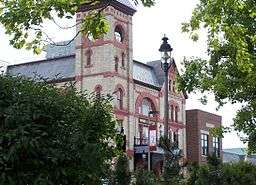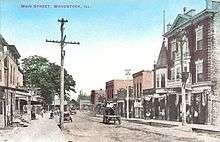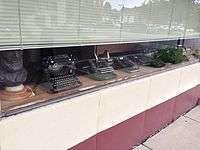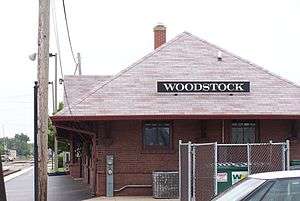Woodstock, Illinois
| Woodstock | |
| City | |
 The Woodstock Opera House on the Square in historic downtown Woodstock | |
| Motto: "True to Its Past; Confident of Its Future" | |
| Country | United States |
|---|---|
| State | Illinois |
| County | McHenry |
| Townships | Dorr, Greenwood, Hartland, Seneca |
| Coordinates | 42°19′3″N 88°26′46″W / 42.31750°N 88.44611°WCoordinates: 42°19′3″N 88°26′46″W / 42.31750°N 88.44611°W |
| Area | 13.55 sq mi (35 km2) |
| - land | 13.55 sq mi (35 km2) |
| - water | 0.00 sq mi (0 km2) |
| Population | 24,770 (2010) |
| Density | 2,304.5/sq mi (890/km2) |
| Founded | 1852 |
| Mayor | Dr. Brian Sager |
| Timezone | CST (UTC-6) |
| - summer (DST) | CDT (UTC-5) |
| Postal code | 60098 |
| Area code | 815/779 |
|
Location of Woodstock within Illinois and the Chicago area | |
| Wikimedia Commons: Woodstock, Illinois | |
| Website: www.woodstockil.gov | |
Woodstock is a city in and the county seat of McHenry County, Illinois, United States, located 51 miles (82 km) northwest of Chicago.[1] The population was 24,770 as of the 2010 census. The city's downtown includes a historic, turn-of-the-century town square, which is anchored by the landmark Woodstock Opera House and Old McHenry County Courthouse. The city was named one of the nation's Dozen Distinctive Destinations in 2007 by the National Trust for Historic Preservation.[2]
History

Early days, Centerville
Centerville, as Woodstock was originally called, was chosen as the county seat on September 4, 1843, due to its location at the geographic center of McHenry County. Early area settler Alvin Judd developed a plat for the town, incorporating a two-acre public square, near which a 2-story frame courthouse and jail were constructed the following year by George C. Dean and Daniel Blair. In 1845, resident Joel Johnson's proposed that Centerville be given a more original name, and so the town was renamed Woodstock after Johnson's hometown of Woodstock, Vermont. (The town was listed as "Center" on the 1850 Federal Census, however.) In 1852, Woodstock was incorporated as a village with Judd as president. In response to a burgeoning population following the Civil War, Woodstock was incorporated as a city in 1873. John S. Wheat was elected as Woodstock's first mayor. A vital artery for the growing town was the train line to and from Chicago, which allowed for a substantial industrial presence early in the town's history.[3]
Eugue V. Debs' prison stay
In 1895, Eugene V. Debs served out a short federal prison sentence in the Woodstock Jail following the 1894 Pullman labor strike in Chicago. Debs, the former president of the American Railway Union, was held in Woodstock instead of Chicago because federal officials feared that he would be surrounded with too many sympathizers in a Chicago prison and therefore could have still incited further violence. Debs was instead assigned to a cell in the newly constructed Woodstock Jail, which occupied the lowest floor of the Woodstock Courthouse on the town square. During his time in jail, Debs received several influential socialist visitors and encountered the works of Karl Marx. By the time he was released in 1895 (purportedly before 10,000+ onlookers assembled in the Woodstock Square), Debs had become a socialist. He later ran for the United States Presidency under the newly formed Social Democratic Party against William McKinley and William Jennings Bryan, and then again in 1904.[4]
"Typewriter City"

During the early part of the 20th century, Woodstock had become "Typewriter City." Home to the factories of both the Emerson Typewriter Company and the Oliver Typewriter Company, Woodstock workers had built more than half the world's typewriters by 1922.[3] The companies were very much a part of life in the city during this time. Both factories had active social clubs, baseball teams that competed against one another, and Emerson even had a well-regarded band that played at public events. In 1919, Emerson Typewriter became the Woodstock Typewriter Company. The city grew and flourished with increasing demand for Woodstock typewriters up through and after World War II. Initially the company sold typewriters for use in the war effort domestically and abroad, but even after the war's end returning servicemen, now familiar with the Woodstock brand, chose these models for their households. The factory was in use until 1970, and has since been converted in to lofts.[5][6]
Orson Welles and the Todd School for Boys
Woodstock had an important role in the creative development of Orson Welles. In 1926 at age 10, in the midst of a chaotic upbringing, he enrolled at the Todd School for Boys in Woodstock. His five-year stay there was his only education, but the town and school made an impression on the young Welles. Years later, in 1960, when asked where he thought of as his hometown, he replied "I suppose it's Woodstock, Illinois, if it's anywhere. I went to school there for four years. If I try to think of a home, it's that." [7][8]
At Todd School, the young Welles came under the positive influence and guidance of Roger Hill, a teacher who later became the school's headmaster. Hill provided Welles with an educational environment that supported his creativity, allowing Welles to concentrate on subjects that interested him. Welles performed and staged his first theatrical experiments and productions at Todd. He also performed at the downtown Woodstock Opera House, where the stage — the site of his American debut as a professional theatre director — is now dedicated to him.[9][10] Welles returned to Woodstock periodically after leaving school. In July 1934 at the age of 19, he coordinated the Todd Theatre Festival, a six-week summer festival at the Woodstock Opera House that featured Hilton Edwards and Micheál MacLiammóir of Dublin's Gate Theatre.[11]:165 His short film The Hearts of Age was shot on the Todd School campus during the festival.[12][13]
Todd School for Boys closed in 1954, and several original buildings were purchased at auction and reused by Marian Central Catholic High School and Christian Life Services.[14] Welles' former dormitory was demolished in 2010.[15]
Role in movies
Groundhog Day, 1993
Woodstock is perhaps most famous for its role as the location for the 1993 movie Groundhog Day, starring Bill Murray. Although the story is set in Punxsutawney, Pennsylvania, the movie's producers preferred the quintessentially American backdrop of the Woodstock Square and its surroundings. Outdoor and street scenes were filmed around the downtown and various side streets, and signs from stores and businesses are visible throughout the movie. [16] Many notable scenes' locations are commemorated with plaques as part of a walking tour for visitors and enthusiasts.[17] Additionally, the bed and breakfast in which Bill Murray's character stays is a few blocks from the Square and was formerly a private residence, but in recent years it has been opened as a functioning bed and breakfast where visitors can stay.[18]
Planes, Trains and Automobiles, 1987
Several scenes in the 1987 film Planes, Trains, and Automobiles were shot in Woodstock, including the scene in which the protagonists' rental car is towed in front of a building (the old Courthouse).[16] The movie brought Woodstock to the attention of location manager Bob Hudgins, who later recommended the town to Harold Ramis for the filming of Groundhog Day. [19]
Local Culture

Annual traditions
- Farmers Market (year-round, hours vary by season)
- Groundhog Day (February)
- The town celebrates "Groundhog Day" at the beginning of every February, including tours of famous filming sites from the 1993 movie. The town uses its own groundhog "Woodstock Willie" to perform the same tasks as "Punxsutawney Phil" does in the original Groundhog Day festival in Punxsutawney, Pennsylvania. Every year on the weekend of Groundhog Day, the Classic Cinemas Woodstock Theater shows the movie Groundhog Day for free.
- Woodstock City Band Concerts (summer)
- One of Woodstock's longest standing summertime traditions (starting in 1885), these free Wednesday night summer concerts are held in the Park in the Square and are often accompanied by an ice cream social.
- Fair Diddley Craft Show (May)
- Woodstock Challenge Road Run (June)
- An annual family run/walk race (10K, 5K, 1 mile and 1/2-mile) through Emricson Park, sponsored by the Woodstock Recreation Department.[20]
- Woodstock Folk Festival (July)
- Jazz on the Square Festival (August)
- McHenry County Fair (August)
- HarvestFest (August)
Lighting of the Square (November)
- Held the Friday after Thanksgiving, this celebration formally marks the beginning of the Christmas season downtown. Crowds gather after dark in the Square, sing carols and visit local shops. After a small presentation from the mayor, City council representative and Santa Claus, Miss Woodstock moves to her oversized light switch and starts the crowd's countdown. When the switch is flipped the whole downtown lights up as Christmas lights on every tree and building are turned on all at once.[21]
Local newspaper
The Woodstock Independent is the award-winning local paper of record and is delivered weekly to subscribers.[22] Published on Wednesdays, The Independent covers community news, events as well as local government and schools. The Independent also publishes The Torch, a feature-oriented magazine delivered free to all Woodstock residents 8 or 9 times a year.[23]
Music
Woodstock has become an important destination for live music in McHenry County and the region with venues featuring local, national, and international artists.
A number of organizations support and promote live music in Woodstock:
- Liquid Blues
- Jazz on the Square
- Off Square Music
- Opera Woodstock
- RIFF Productions
- Woodstock Folk Festival
- Woodstock City Band
- Potts & Pans Steelband[24]
Religion
Woodstock is home to many Protestant and Catholic churches, a Jewish congregation and a Buddhist temple. The Blue Lotus Buddhist Temple, founded in 2002 by Bhante Sujatha, is an internationally recognized Sri Lankan Buddhist Temple and draws people from much of northern Illinois and southern Wisconsin.
Education
Woodstock's public schools are part of Woodstock Community Unit School District 200, which was formed in 1969.[25] The district currently operates 6 elementary schools (Dean Street, Greenwood, Mary Endres, Olson, Prariewood and Westwood), two middle schools (Northwood and Creekside) and two high schools (Woodstock High School and Woodstock North High School).[26][26] The three newest buildings, Prariewood, Creekside and WNHS, were approved in a March 2006 referendum to address crowding in schools due to the area's growth between the mid-90s and 2008.[25]
Woodstock is also currently served by private educational institutions: St. Mary Catholic grade school (K-8) is located in town and students often continue on to Marian Central Catholic High School, also located in Woodstock.
Residents pursuing an associate degree normally do so at McHenry County College in neighboring Crystal Lake. Loyola University Chicago owns and operates a large property on Woodstock's eastern edge as its Retreat and Ecology Campus.[27] Aurora University also operates its Woodstock Center downtown.
Economy

Top employers
According to Woodstock's 2015 Comprehensive Annual Financial Report,[28] the top employers in the city are:
| # | Employer | # of Employees |
|---|---|---|
| 1 | McHenry County | 1,400 |
| 2 | Woodstock Community Unit School District 200 | 1,010 |
| 3 | Centegra Health System | 1,111 |
| 4 | Catalent | 830 |
| 5 | Claussen Pickle Company | 325 |
| 6 | Charter Dura-Bar | 290 |
| 7 | Walmart | 280 |
| 8 | Silgan Tubes Corporation | 211 |
| 9 | Guardian Electric Manufacturing | 150 |
| 10 | Wolf Distribution | 110 |
Transportation

Woodstock's railroad station is the penultimate stop on Metra's Union Pacific Northwest Line, which originates in Chicago's Ogilvie Transportation Center and ends in Harvard, Illinois.
U.S. Route 14 once took drivers through the heart of downtown Woodstock, but a modern bypass now curves around the city's southwest border. Illinois Route 47 runs through town in the north-south direction. Illinois Route 120's western terminus is in northwest Woodstock, and continues east past Woodstock's downtown and into rural McHenry County.
Notable people
- Jack Allen, professional baseball infielder for the Syracuse Stars and the Cleveland Blues
- Alexander Berkman, anarchist and political activist[29]
- Jessica Biel, actress and model
- Bob Bird, Alaskan pro-life and political activist, first Distinguished Alumnus of Marian Central, graduated in 1969.
- Bryan Bulaga, football player, University of Iowa and Green Bay Packers
- Rick Fletcher, illustrator and cartoonist with Chicago Tribune; best known for The Old Glory Story and Dick Tracy
- Emma Goldman, anarchist and political activist
- Chester Gould, cartoonist and the creator of the Dick Tracy comic strip
- Nikol Hasler, author, sexual educator, internet personality
- Dana Nafziger, football player
- Doug Oberhelman, CEO, Caterpillar Inc.
- Scott Sobkowiak, pitcher for the Atlanta Braves
- Barbara Stcherbatcheff, best-selling author and economic commentator
- Lynn D. Stewart, Illini star player from the 1960s and co-founder of the Hooters Restaurant chain[30]
- Johnny Stompanato, mob associate of Mickey Cohen, boyfriend of Lana Turner: killed by Turner's daughter, Cheryl Crane, in self-defense
- Michele Weiner-Davis, marriage therapist and author
- Orson Welles, director, writer, actor, producer, 1931 graduate of the Todd School for Boys[11]:3
Geography

According to the 2010 census, Woodstock has a total area of 13.55 square miles (35.09 km2), all land.[31]
Demographics
| Historical population | |||
|---|---|---|---|
| Census | Pop. | %± | |
| 1860 | 1,327 | — | |
| 1870 | 1,574 | 18.6% | |
| 1880 | 1,475 | −6.3% | |
| 1890 | 1,683 | 14.1% | |
| 1900 | 2,502 | 48.7% | |
| 1910 | 4,331 | 73.1% | |
| 1920 | 5,523 | 27.5% | |
| 1930 | 5,471 | −0.9% | |
| 1940 | 6,123 | 11.9% | |
| 1950 | 7,192 | 17.5% | |
| 1960 | 8,897 | 23.7% | |
| 1970 | 10,226 | 14.9% | |
| 1980 | 11,725 | 14.7% | |
| 1990 | 14,353 | 22.4% | |
| 2000 | 20,151 | 40.4% | |
| 2010 | 24,770 | 22.9% | |
| Est. 2015 | 25,189 | [32] | 1.7% |
As of the census[34] of 2000, there were 20,151 people, 7,273 households, and 4,843 families residing in the city. The population density was 1,891.1 people per square mile (729.9/km²). There were 7,599 housing units at an average density of 713.1 per square mile (275.2/km²). The racial makeup of the city was 87.48% Caucasian American, 1.06% African American, 0.23% Native American, 2.01% Asian, 7.69% from other races, and 1.52% from two or more races. Hispanic or Latino of any race were 19.01% of the population.
There were 7,273 households out of which 37.5% had children under the age of 18 living with them, 52.7% were married couples living together, 9.7% had a female householder with no husband present, and 33.4% were non-families. 27.3% of all households were made up of individuals and 9.2% had someone living alone who was 65 years of age or older. The average household size was 2.68 and the average family size was 3.30.
In the city the population was spread out with 27.9% under the age of 18, 10.2% from 18 to 24, 33.2% from 25 to 44, 18.9% from 45 to 64, and 9.8% who were 65 years of age or older. The median age was 32 years. For every 100 females there were 100.8 males. For every 100 females age 18 and over, there were 98.5 males.
The median income for a household in the city was $47,871, and the median income for a family was $54,408. Males had a median income of $40,137 versus $27,264 for females. The per capita income for the city was $23,210. About 5.3% of families and 7.2% of the population were below the poverty line, including 8.0% of those under age 18 and 3.0% of those age 65 or over.
See also
- Real Woodstock - Tourism and Visitor Guides
- AV Club - "We visit the town that brought Groundhog Day to life"
- Midwest Living Magazine - "25 Weekend Getaways Near Chicago"
- History of Woodstock
- City of Woodstock official website
References
- ↑ "Find a County". National Association of Counties. Archived from the original on 2011-05-31. Retrieved 2011-06-07.
- ↑ "Archived copy". Archived from the original on January 20, 2009. Retrieved December 10, 2008.
- 1 2 "Woodstock, IL". Encyclopedia.chicagohistory.org. Retrieved 2016-03-31.
- ↑ "Archived copy". Archived from the original on August 8, 2007. Retrieved September 8, 2007.
- ↑ "Woodstock, by Nancy Baker".
- ↑ "Emerson Lofts - Models | Our luxurious one and two bedroom lofts feature a perfect blend of historical and contemporary style.". www.emersonlofts.com. Retrieved 2016-11-22.
- ↑ "Archived copy". Archived from the original on October 12, 2010. Retrieved October 9, 2010.
- ↑ "Close Up: Orson Welles, part 1". Interview by Bernard Braden, Canadian Broadcasting Corporation, February 25, 1960 (22:58–23:12). Retrieved 2014-09-26.
- ↑ "Orson Welles 1934 Todd Theatre Festival 80th Anniversary". Woodstock Opera House. Retrieved 2014-09-26.
- ↑ "Orson Welles Stage dedicated at Woodstock Opera House". Wellesnet. February 10, 2013. Retrieved 2014-09-26.
- 1 2 Tarbox, Todd, Orson Welles and Roger Hill: A Friendship in Three Acts. Albany, Georgia: BearManor Media, 2013, ISBN 1-59393-260-X.
- ↑ "Todd School for Boys 1848–1954, Woodstock, Illinois" (PDF). Woodstock Public Library. Retrieved 2014-09-26.
- ↑ "Orson Welles is Dead at 70; Innovator of Film and Stage". www.nytimes.com. Retrieved 2016-11-22.
- ↑ Channick, Robert (5 September 2008). "In Woodstock, historic dorm for boys school attended by Orson Welles faces demolition". Chicago Tribune. Retrieved 28 April 2014.
- ↑ "About Hearthstone Communities". Hearthstone Communities. Retrieved 28 April 2014.
- 1 2 "Groundhog Day (1993)". IMDb. Retrieved 31 March 2016.
- ↑ "Every Day is Groundhog Day in Woodstock, IL!". Woodstockgroundhog.org. Retrieved 2016-03-31.
- ↑ "HOME". Royalvictorianmanor.com. 2016-02-04. Retrieved 2016-03-31.
- ↑ "We visit the town that brought Groundhog Day to life · Pop Pilgrims · The A.V. Club". Avclub.com. Retrieved 2016-03-31.
- ↑
- ↑ "Archived copy". Archived from the original on July 17, 2011. Retrieved November 25, 2010.
- ↑ "Archived copy". Archived from the original on October 17, 2010. Retrieved October 9, 2010.
- ↑ "Archived copy". Archived from the original on October 17, 2010. Retrieved October 9, 2010.
- ↑ "Potts & Pans, Inc. NFP". Pottsandpans.org. Retrieved 2013-11-21.
- 1 2 "Archived copy". Archived from the original on August 21, 2009. Retrieved March 6, 2010.
- 1 2 "Archived copy". Archived from the original on February 21, 2009. Retrieved March 6, 2010.
- ↑ "Retreat & Ecology Campus: Loyola University Chicago". Loyola University Chicago - Retreat & Ecology Campus. Retrieved 2016-11-22.
- ↑ "City of Woodstock : Woodstock, Illinois" (PDF). Woodstockil.gov. Retrieved 2016-03-31.
- ↑ "Alexander Berkman : Biography". Spartacus.schoolnet.co.uk. Retrieved 2013-11-21.
- ↑ "Illini Legends, Lists & Lore: Lynn Stewart | News-Gazette.com". Illinihq.com. 2009-10-04. Retrieved 2016-03-31.
- ↑ "G001 - Geographic Identifiers - 2010 Census Summary File 1". United States Census Bureau. Retrieved 2015-12-27.
- ↑ "Annual Estimates of the Resident Population for Incorporated Places: April 1, 2010 to July 1, 2015". Retrieved July 2, 2016.
- ↑ "Census of Population and Housing". Census.gov. Archived from the original on May 11, 2015. Retrieved June 4, 2015.
- ↑ "American FactFinder". United States Census Bureau. Archived from the original on 2013-09-11. Retrieved 2008-01-31.

